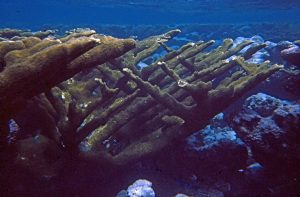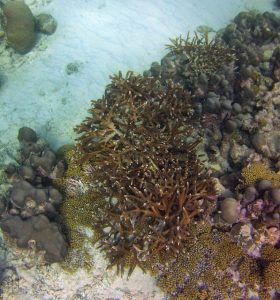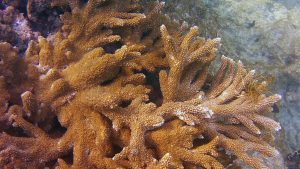Navigation
Barbados Fringing Reefs & Seagrass Beds
— Obs I
— — The Acroporoids (This Page)
| On this page (Background): 1. ACROPOROIDS 2. ACROPORA SPECIES 3. ACROPORA SPECIES IN THE CARIBBEAN 4. THE CARIBBEAN ACROPORA SPECIES ARE ENDANGERED 5. SOME KEY LIT & LINKS |
Subpages/Observations: – All 3 Acropopoids occur on Vauxhall Reef – A palmata – A. cervicornis – A. prolifera& View Effects of 2023 extreme warming events on the 3 Acroporoids |
1. ACROPOROIDS (from Wikipedia)
The term Acroporoid refers to the coral family Acroporidae, “a family of small polyped stony corals…The name is derived from the Greek “akron” meaning “summit” and refers to the presence of a corallite at the tip of each branch of coral. (Wikipedia: Acroporidae)
There ere 5 genera: (Wikipedia: Acroporidae)
– Anacropora,
– Astreopora
– Montipora are found in the Indian and Pacific Ocean.
– Enigmopora is represented by a single new species, Enigmopora darveliensis,[5] found in Malaysia and the Philippines
– Acropora is cosmopolitan and is both common and conspicuous, usually being dominant in Indo-Pacific reefs. “Acropora species are some of the major reef corals”
2. ACROPORA SPECIES
“Acropora” is a genus of corals which includes important coral reef-builders in the Caribbean (or’Wider Caribbean’/Tropical Atlantic) and the Indo-Pacific*, the two major provenances of coral reefs world-wide.
There are circa 150 species of Acropora in the Indo-Pacific, but only 3 in the Caribbean, a pattern in diversity reflected in most species groups between the two regions (see Spaulding 2001 page 19ff – Patterns of Diversity).
See Wikipedia – Acropora for a list of all Acropora species.
3. ACROPORA SPECIES IN THE CARIBBEAN (from Wikipedia).
There are 3 species, one of them a hybrid between the other two.
(i) Acropora palmata (elkhorn coral) is an important reef-building coral in the Caribbean. The species has a complex structure with many branches which resemble that of elk antlers; hence, the common name.Although Elkhorn coral dominated the Caribbean in the early 1980s, the species has since dramatically declined in numbers. Scientists have estimated that between 1980 and 2006, when it was listed in the Endangered Species Act (ESA), the population declined by around 97%. This decline was due to a variety of factors, including disease, algae growth, climate change, ocean acidification, and human activity. In May 2006, Elkhorn coral was officially listed as threatened in the Endangered Species Act [U.S.A] along with another species in the Acropora genus, staghorn coral.
(ii) Acropora cervicornis (staghorn coral) is a branching, stony coral with cylindrical branches ranging from a few centimetres to over two metres in length and height. It occurs in back reef and fore reef environments from 0 to 30 m (0 to 98 ft) depth…Until the mid-1980s, the intermediate depths of 5–25 meters (16–82 feet) in the fore reef zones were once primarily occupied by vast areas of staghorn coral, consisting largely of single-species stands. Staghorn corals can exhibit very fast growth, adding up to 5 cm (~2 in) in new skeleton for every 1 cm of existing skeleton each year; this makes them one of the fastest growing fringe coral species in the western Atlantic. Therefore, staghorn corals have been one of the three most important Caribbean corals in terms of its contribution to reef growth and fishery habitat.
(iii) Acropora prolifera (fused staghorn coral) is very similar to staghorn coral (Acropora cervicornis) in appearance but usually forms smaller, denser clumps. The branches are mostly horizontal and often divide near the tip, sometimes fusing with other branches. It also resembles elkhorn coral (Acropora palmata) and genetic studies show that it is a hybrid between that and staghorn coral.
4. THE CARIBBEAN ACROPORA SPECIES ARE ENDANGERED
Up to the 1960s and 1970s, A. palmata and A . cervicornis were thriving on many Caribbean Reefs.* In the 1970s/1980s, populations in most areas were severely reduced largely due to the appearance of a novel, “white band disease“.
* A. palmata and A . cervicornis are major components of the uplifted Pleistocene reefs of Barbados (Mesolella, 1967). However, A. palmata was rare in Barbados in the late 1950s, early 1960s when John Lewis described the fringing reefs (Lewis, 1960). Based on later studies (Lewis, 1984), he suggested that A, palmata “probably flourished in Barbados into the present century (1900s) but has now declined”; he believed the loss of A. palmata was largely due to land clearance and agricultural activities beginning in the 1600s.
In the mid 2000s, A. palmata and A . cervicornis were listed as “threatened” under the U.S. Endangered Species Act. The fused-staghorn coral (A prolifera), was not so listed as “it is identified as a hybrid and doesn’t fall under the ESA’s definition of a distinct species.”
5. SOME KEY LIT & LINKS
Functional consequences of the long-term decline of reef-building corals in the Caribbean: evidence of across-reef functional convergence. Nuria Estrada-Saldívar et al., 2019 in Royal Society Open Science Oct 2019 Vol 6, Issue 10. “…we evaluate how coral communities have changed in the northern sector of the Mexican Caribbean between 1985 and 2016, and the implications for the maintenance of physical reef functions in the back- and fore-reef zones. Over a period of 31 years, ecological homogenization occurred between the two reef zones mostly due to a reduction in the cover of framework-building branching (Acropora spp.) and foliose-digitiform (Porites porites and Agaricia tenuifolia) coral species in the back-reef, and a relative increase in non-framework species in the fore-reef (Agaricia agaricites and Porites astreoides). This resulted in a significant decrease in the physical functionality of the back-reef zone.”
Mapping the return of acroporid corals on fringing reefs along the west coast of Barbados
R. MACLEAN AND H.A. OXENFORD, 2016. Centre for Resource Management and Environmental Studies (CERMES), The University of the West Indies,
Cave Hill Campus, Barbados
The Acropora inheritance: a reinterpretation of the development of fringing reefs in Barbados, West Indies.
Lewis J. B. 1984 in Coral Reefs 3:117-122. “The discovery of the widespread occurrence of the remains of the reef coral Acropora palmata within the fabric of the fringing reefs on the west coast of Barbados requires a new interpretation of their Holocene development. Radiocarbon dating of the A. palmata framework suggests that reef construction by this species began as early as 2,300 years B.P. A. palmata probably flourished in Barbados into the present century but has now declined. The present fringing reefs are characterized by a core and base of A. palmata upon which subsequent colonization took place, especially by Montastrea annularis, Porites porites and coralline algae.”
The demise of a major Acropora palmata bank–barrier reef off the southeast coast of Barbados, West Indies
IG Macintyre et al., 2007. In Coral Reefs Volume 26, pages 765–773
Formerly attributed to human activity, the demise of a bank–barrier reef off southeastern Barbados known as Cobbler’s Reef is now thought to be largely the result of late Holocene, millennial-scale storm damage. Eleven surface samples of the reef crest coral Acropora palmata from nine sites along its 15-km length plot above the western Atlantic sea-level curve from 3,000 to 4,500 cal years ago (calibrated, calendar 14C years). These elevated clusters suggest that the reef complex suffered extensive storm damage during this period. The constant heavy wave action typical of this area and consequent low herbivory maintain conditions favoring algal growth, thereby limiting the reestablishment of post-storm reef framework. Site descriptions and detailed line surveys show a surface now composed mainly of reworked fragments of A. palmata covered with algal turf, macroalgae and crustose coralline algae. The reef contains no live A. palmata and only a few scattered coral colonies consisting primarily of Diploria spp. and Porites astreoides, along with the hydrocoral Millepora complanata. A few in situ framework dates plot at expected depths for normal coral growth below the sea-level curve during and after the period of intense storm activity. The most recent of these in situ samples are 320 and 400 cal years old. Corals of this late period likely succumbed to high turbidity associated with land clearance for sugarcane agriculture in the mid-1600s.”
Acropora 2023: Heat-related Mortality, Resistance or Rescue. What’s happening? What can we learn? What’s next?
Acropora 2023: Heat-related Mortality, Resistance or Rescue
November 13, 2023. Webinar presented by Caribbean Cooperation Team & AGRRA Partners Meeting
Topics:
– Introduction
– Esther Peters: Mysteries Abound: Pathogenic Agents
of Disease
– Examples of Mortality, Resistance or Rescue:
– Genevieve Renaud-Byrne & Ruleo Camacho: Antigua
– Lisa Carne: Belize
– Felix Charnley: Jamaica
– Emily Becker: Florida
– Group Discussion: Rethinking Coral Rescues for a Warmer World
Transcript is available to follow.




